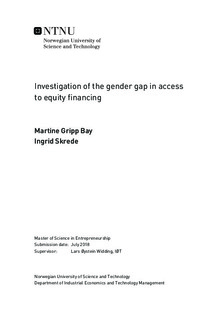Investigation of the gender gap in access to equity financing
Master thesis
Permanent lenke
http://hdl.handle.net/11250/2578829Utgivelsesdato
2018Metadata
Vis full innførselSamlinger
Sammendrag
Today, there is an overwhelming gender gap in the equity funding rates in the U.S. Last year, only 6% of the entrepreneurs that received funding from business angels were women, though 27% of the entrepreneurs seeking angel investments were female. Today, 17% of the male and 11% of female population is working in startups. This means that the equity funding is disproportionately divided among men and women. As women are majority owners of 10 million businesses, with an economic impact of $3 trillion, they have an enormous impact on the economy. Due to the lack of research, and the importance of understanding the underlying reasons for the gender differences, the purpose of this study is thus: To gain a better understanding of the gender gap in equity financing.
According to research, the importance of skills and knowledge (human capital), and the use of strategic networks (social capital) differ for male and female entrepreneurs. In addition, research shows that traits entrepreneurs show through behavior (gender characteristics) influence investors perceptions of them. As the existing literature uses gender neutral measures to explain these phenomenon, it overlooks the effect of gender biases. This study takes this into account when investigating human capital, social capital and gender characteristics. When using gender lenses on these factors, an increased understanding of the gender gap in equity financing is achieved. By doing so, this study contributes with building new theory, as the theoretical frameworks are applied in a unique way.
A qualitative, multiple case study approach was followed, with multiple sources of evidence to allow for triangulation. The data was analyzed using software, and by comparative pattern matching. It showed that the importance of human capital is situation dependent, and the importance could therefore not be decided. The findings showed, however, that female entrepreneurs and investors had more clear opinions than men. In terms of social capital, it was seen that women used networks to a higher degree than men to collect resources. Lastly, it was seen that male and female entrepreneurs showed mostly masculine and androgynous characteristics. This study has implications for scholars, entrepreneurs and investors, as it shows that gender biases need to be taken into account. The strength of the findings was, however, limited by biases, language and cultural barriers, calculations of gender characteristics, criteria and cases.
